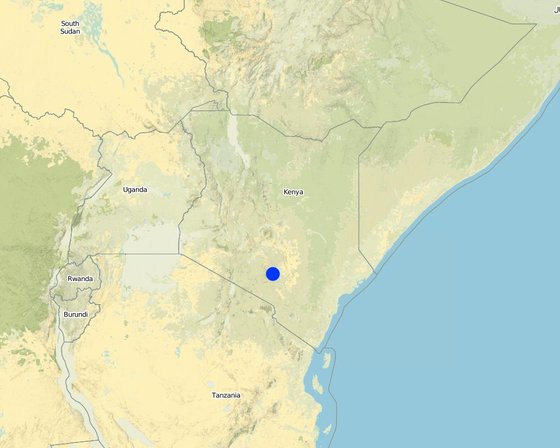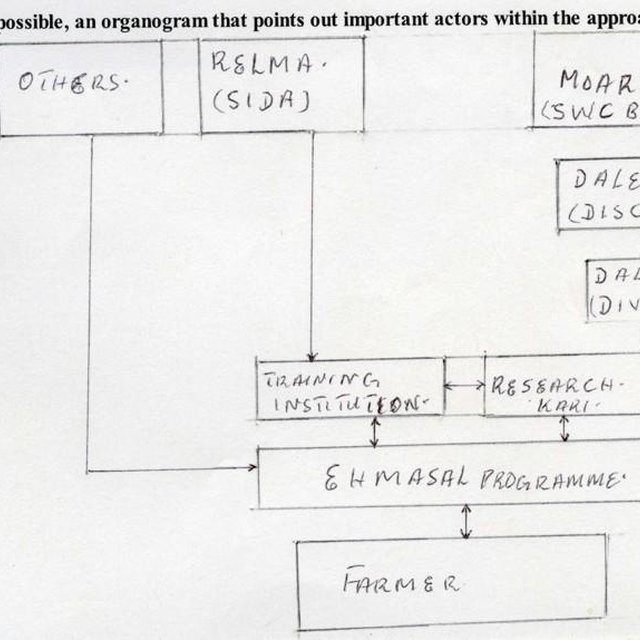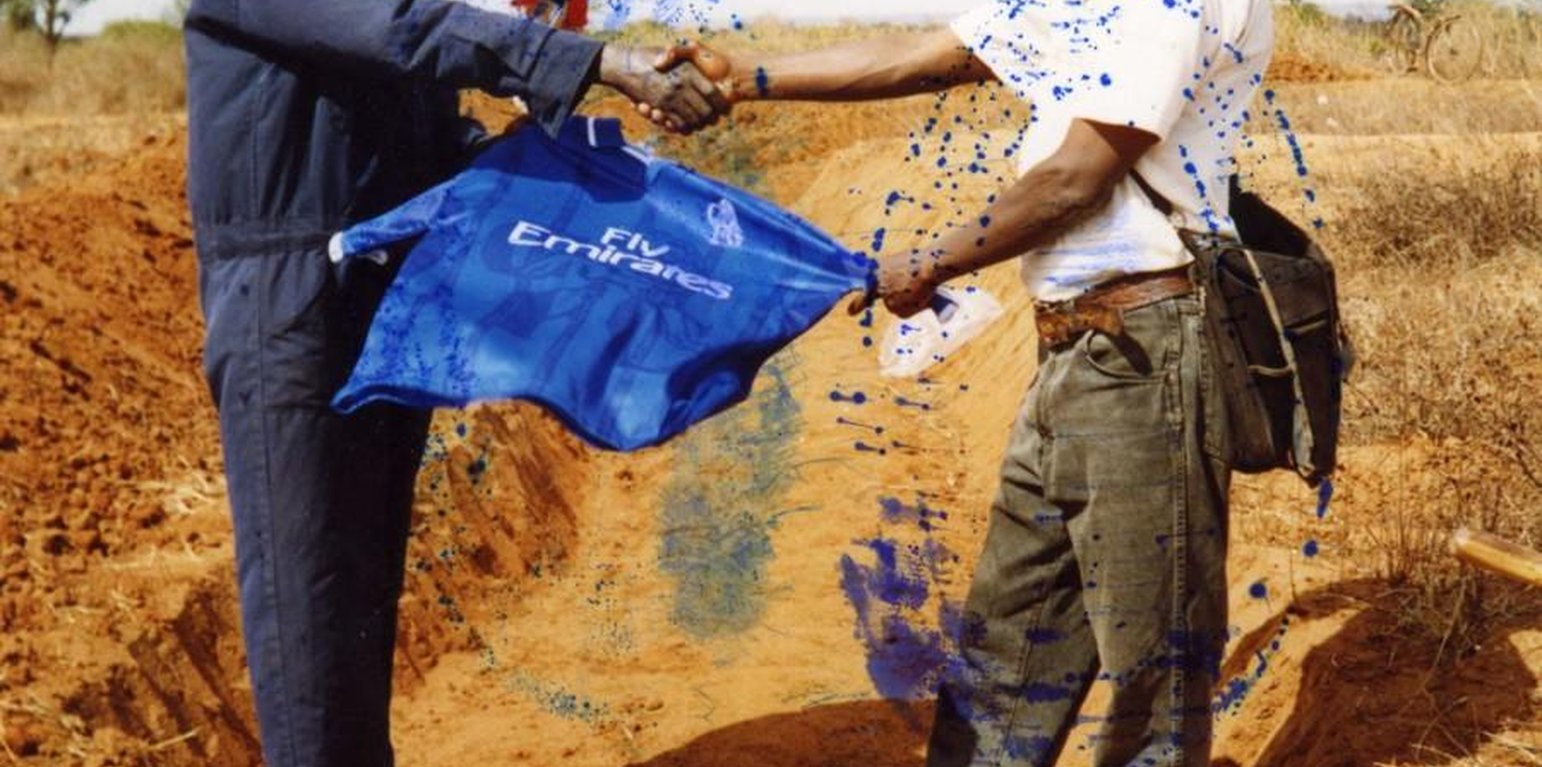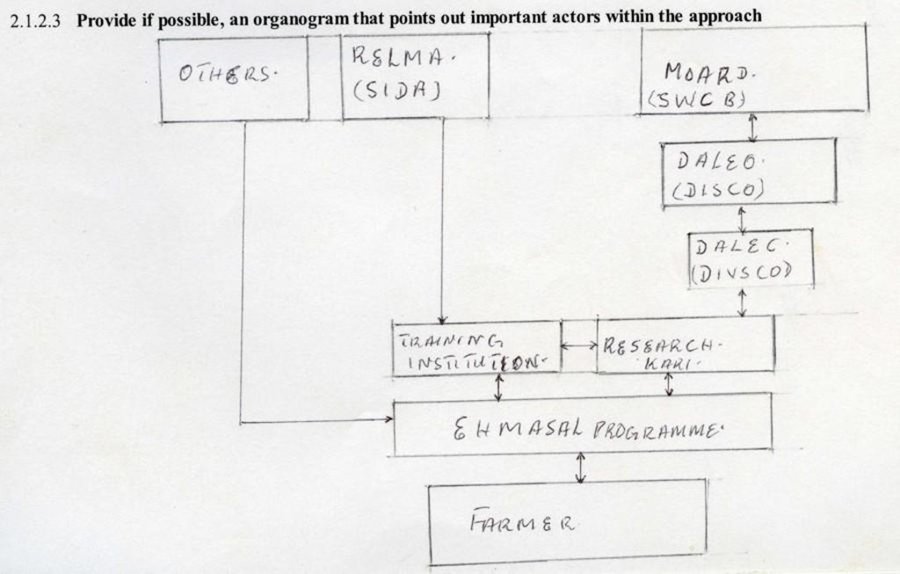water harvesting
(Kenya)
Description
Water harvesting for agricultural production in ASALS.
Aims / objectives: Water harvesting to enhance extra moisture and for reduced risks of crop failure. The technology combines retention/infiltration ditches, bench terraces, appropriate tillaging, manure use, water channels diverting run off from either high ways or natural waterways and stabilization of SWC embankment. Implementation is made by land users with guidance of SWC specialists. Land users may be a group or individual, though the land use type is individual ownership.
Other important information: Most of part 2: specification of SWC approach, QA2.11.3-QA2.5.2.3 were answered with assumptions since there never existed other projects in the area before this indigeneous one known as extra humid in arid and semi-arid lands (EHMASAL) programme established in 2000 to provide land users with the existing SWC technologies and methods of approaches to meet the prevailing need of self-sufficience and food security. The programme strategies are attached.
Location

Location: Eastern province, Kenya
Geo-reference of selected sites
Initiation date: 2000
Year of termination: n.a.
Type of Approach
-
traditional/ indigenous
-
recent local initiative/ innovative
-
project/ programme based

Area of the approach.

Organogram.
Approach aims and enabling environment
Main aims / objectives of the approach
The Approach focused mainly on SLM with other activities (Timeliness in planting/transplanting, seed selection, seedlings variety and breeds for the AEZ.)
To harvest runoff and spread it on cropped area to maximize agricultural productivity. To improve crop moisture requiremnet. To reduce risks of crop failure stimulated by aridity in ASALs. To control soil erosion by water and wind. To improve the inflitration rate. To enhance food security for self-sufficiency and reliance.
The SLM Approach addressed the following problems: Inadequency of soil moisture resulting to crop failure. Inefficiency of approach to improve the situation. Fertility depletion due to continuous cultivation. Soil crusting caused by erosion, poor tillaging, overgrazing and deforestation (degadation).
Conditions enabling the implementation of the Technology/ ies applied under the Approach
-
Legal framework (land tenure, land and water use rights): The existing land ownership, land use rights / water rights greatly helped the approach implementation: Land ownership/land use rights help implementation of the approach since benefits are realized by the sole land user.
Conditions hindering the implementation of the Technology/ ies applied under the Approach
-
Availability/ access to financial resources and services: The much need be done on SWC in ASAL is beyond the sole land user for hand
Treatment through the SLM Approach: It requires financial support by source of loans and market orientation
-
Legal framework (land tenure, land and water use rights): No empowerment on land use law or bylaws
Treatment through the SLM Approach: Enforcement by legislation on land use policy.
-
Knowledge about SLM, access to technical support: poor land treatment-plans, poor land husbandry, low knowledge
Treatment through the SLM Approach: Interaction in land use change, especially with SWC specialists
Participation and roles of stakeholders involved
Stakeholders involved in the Approach and their roles
| What stakeholders / implementing bodies were involved in the Approach? |
Specify stakeholders |
Describe roles of stakeholders |
| local land users/ local communities |
Land user/local SWC specialists. Working land users were work equally divided between men and women (The family leader organizes for activity implementation either family labour or casuals). Women are majority for reason that men are engaged on off-farm. Employmentproportion is about 3 women to 1 man. Mostly women in public meetings and open field days |
|
| SLM specialists/ agricultural advisers |
|
|
| national government (planners, decision-makers) |
Water harvest for agricultural production RESCU 1996. Run off farming ministry of agriculture, Nairobi |
|
Involvement of local land users/ local communities in the different phases of the Approach
none
passive
external support
interactive
self-mobilization
initiation/ motivation
Mainly:public meetings; partly: workshops/seminars; public meetings for initial awareness. Workshops/seminars for technical assistance for approach
planning
Mainly: workshops/seminars; partly: public meetings; innovators land users seminar
monitoring/ evaluation
Mainly: reporting; partly: measurements/observations; correct dimensions, monthly progress report
Decision-making on the selection of SLM Technology
Decisions were taken by
-
land users alone (self-initiative)
-
mainly land users, supported by SLM specialists
-
all relevant actors, as part of a participatory approach
-
mainly SLM specialists, following consultation with land users
-
SLM specialists alone
-
politicians/ leaders
Decisions were made based on
-
evaluation of well-documented SLM knowledge (evidence-based decision-making)
-
research findings
-
personal experience and opinions (undocumented)
Technical support, capacity building, and knowledge management
The following activities or services have been part of the approach
-
Capacity building/ training
-
Advisory service
-
Institution strengthening (organizational development)
-
Monitoring and evaluation
-
Research
Capacity building/ training
Training was provided to the following stakeholders
-
land users
-
field staff/ advisers
-
extensionists/trainers
Form of training
-
on-the-job
-
farmer-to-farmer
-
demonstration areas
-
public meetings
-
courses
Subjects covered
Only field days and practical substitutes training for a fact that the programme has no source of finance to support trainings.
Advisory service
Advisory service was provided
-
on land users' fields
-
at permanent centres
Runoff farming (water harvesting); Key elements: Infiltration/retention ditches, level bench terraces, soil structure, texture and fertility improvement, macro/micro catchment water harvest bund; 1) Advisory service was carried out through: non-governmental agency 2) Target groups for extension: land users; Activities: SWC activities, water harvest
Advisory service is inadequate to ensure the continuation of land conservation activities; Staff farmer ratio is too high to induce land use change
Institution strengthening
Institutions have been strengthened / established
-
no
-
yes, a little
-
yes, moderately
-
yes, greatly
Describe institution, roles and responsibilities, members, etc.
Type of support
-
financial
-
capacity building/ training
-
equipment
Further details
Monitoring and evaluation
Area treated aspects were regular monitored through measurements
no. of land users involved aspects were ad hoc monitored through observations
There were no changes in the Approach as a result of monitoring and evaluation: The changes may come up season after season due to rainfall characteristics in arid areas. The period is rather short to make a conclusion. No change observed hither to.
Research
Research treated the following topics
-
sociology
-
economics / marketing
-
ecology
-
technology
The existing SWC recommendations were released through the institution
Research was carried out both on station and on-farm
Financing and external material support
Annual budget in USD for the SLM component
-
< 2,000
-
2,000-10,000
-
10,000-100,000
-
100,000-1,000,000
-
> 1,000,000
Precise annual budget: n.a.
Approach costs were met by the following donors: local community / land user(s) (no external support)
The following services or incentives have been provided to land users
-
Financial/ material support provided to land users
-
Subsidies for specific inputs
-
Credit
-
Other incentives or instruments
Impact analysis and concluding statements
Impacts of the Approach
No
Yes, little
Yes, moderately
Yes, greatly
Did the Approach help land users to implement and maintain SLM Technologies?
soil management structurally aiming to make use of previously lost runoff for crop production.
Did the Approach improve issues of land tenure/ user rights that hindered implementation of SLM Technologies?
Did other land users / projects adopt the Approach?
about 20-25% of the other organized groups adopted the approach initially.
Main motivation of land users to implement SLM
Sustainability of Approach activities
Can the land users sustain what hat been implemented through the Approach (without external support)?
About 75% of the land users may continue implementing the SWC activities without financial support in future. What would be required by land user as focused is layout, alignment, generally technology guidance. If other approaches e.g. trainings/seminars were included to all farm production systems.
Conclusions and lessons learnt
Strengths: land user's view
-
increase weight on food security (How to sustain/ enhance this strength: to acquire knowledge of the land husbandry.)
-
introduces off-farm employment (How to sustain/ enhance this strength: proper measures and practices of water harvesting component.)
Strengths: compiler’s or other key resource person’s view
-
The approach focuses on food security and self-sufficiency. (How to sustain/ enhance this strength: Regular maintenance of the SWC structures and agroforestry establishment.)
-
Improve the standard of living if adopted by the community. (How to sustain/ enhance this strength: Enforcement of SWC policy by the government to protect technology areas.)
-
Reduces risk of crop failure due to poor rainfall distribution. (How to sustain/ enhance this strength: Introduce policy of land use right/land ownership.)
-
Reduces soil and water losses through erosion. (How to sustain/ enhance this strength: Introduced land use change and land management (land husbandry practices))
-
Improves national economy as well as family gross income. (How to sustain/ enhance this strength: improvement on market of agricultural products and by-products.)
Weaknesses/ disadvantages/ risks: land user's viewhow to overcome
-
poor marketing system for most of agricultural products and byproducts.
formation of cooperative societies
-
slow in adoption on land use change due to longer period of cost return
government introduces enforcement law to discourage communal land use.
Weaknesses/ disadvantages/ risks: compiler’s or other key resource person’s viewhow to overcome
-
regular crop failure due to erratic rainfall patterns
enhance extra moisture by water harvest and spreading it in cropped area
-
consumes time, energy and money to establish.
No soil, no food. No water, no life. Policy of approach
-
interferes with soil fertility and reduces land size by SWC structures.
Manure and fertilizer application regularly to maximize production level.
-
Slow in cost benefit return from a given area.
marketing orientation for farm products
-
Low income sources of the common land users.
Introduced sources of agricultural loan policy for ASALs.
References
Date of documentation: Jan. 19, 2009
Last update: June 12, 2017
Resource persons
-
Philippe Zahner (philippe.zahner@deza.admin.ch) - SLM specialist
-
Francis Mbote (pc+changeme2@nalep.co.ke) - SLM specialist
-
Kathinji Mutunga - SLM specialist
-
Alex R. Adual - SLM specialist
Full description in the WOCAT database
Documentation was faciliated by
Institution
- International Centre for Research in Agroforestry (ICRAF) - Kenya
- Ministry of Agriculture and Livestock Development of Kenya (MoA) - Kenya
- Swiss Agency for Development and Cooperation (DEZA / COSUDE / DDC / SDC) - Switzerland
Project
Key references
-
SWC manual for Kenya 1997 by D.B. ThomasSoil conservation in Kenya 1981 by C.G.WennerSWC technology development in Kenya by K:MutungaSony super DXE-180 videoThe sun will still rise videoRunoff, a friend or a foe video: agricultiral information centre, freeagricultiral information centre, freeM.A.R.D. SWCB-NBI Kenya, freeSWCB NBI Kenya, freeRELMA/CIDA, freeRELMA/CIDA, free
-
Rainfall runoff analysis by Paul Kimeu. 1-11. Feb. 1998:
-
Water conservation, water harvesting and management (WCHM) scheme design. Practicals (WHIF) exercise. Embu February 1-11 1998:
-
Method of collecting and storing local surface runoff for water supply in central Asian deserts by Prof A.G. Babaer: Desert research institute, Gogolstr.15.
-
Study of traditional water harvesting practices in Cost province, by J.O.Owupo, July 1998:
-
Soil characteristics and properties for water conservation, harvesting and management (WCHM). (WH5) June 29-July 7 1997 by Kithinji Mutunga:
-
Dryland water harvesting (WH), water conservtion (WC) techniques , by K. Mutunga 9-15 July 1995:
-
Design procedure for harvesting and conservation system, by Odoyo J. Bittar. ministry of agriculture, Busia-Kenya, February 1-11, 1998:
-
MINOR ROADS PROGRAMME soil conservation. Pilot project final report 1992agrisystems (EA) Ltd, P.O.Box 39636 Nairobi, free: Agrisystems (EA) Ltd, P.O.Box 39636 Nairobi, free
-
promoting farmer innovatiion . Workshop report No. 2 by Will Critchley 'RELMA' 1999: Free
-
mpact assessment study. National soil and water conservation branch, final report 1998: Agrisystems (EA) Ltd, P.O.Box 39636 Nairobi, free
-
The sustainability of the catchment approach - induced measures and activities, by Yeraswara Admasie (NSWCP). Report in 1998: Free
-
Where ther is no water. SASOL and by Donald B.Thomas 1999. maji na ufanisi P.O.Box 14893 Nairobi: Free
-
ater from sand rivers by Erik Nissen Petersen report No.23, RELMA/SIDA. Kenya 2000:
-
Agroforestry extension manual for northern Zambia, by Henry Chilufya. BO Tengrias , free. RSCU Nairobi technical handbook No.11.:
-
The hand of man. Soil conservation in Kondoa, eroded area Tanzania, by Carl Christiansson, Alfred Mbegu, Andreas Yrgard, RSCU/SIDA 1993 free:
-
Nomadic pastoral appraisal SWCB MALDM P.O. Box 30028 Nairobi, by L.I. Mwarasomba:
-
Curriculum for in service training in agroforestry and related subjects in Kenya. By Stachys M. Muturi. M.A., MENR, Kenya. Forestry research institute, RSCU/SIDA 1992:







